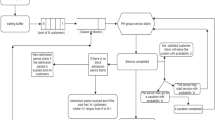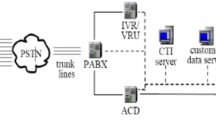Abstract
A finite queuing system with one server, Poisson input flow, arbitrary service time distribution, and hysteretic policy for arrival rate control is considered. An analytical method is proposed for determination of the stationary distribution of the number of customers in the system. Several numerical examples are given.
Similar content being viewed by others
References
P. O. Abaev, Yu. V. Gaidamaka, and K. E. Samuilov, “Hysteresis management of signal workload in net of SIP-servers,” Vestn. Ross. Univ. Druzhby Narodov, Mat. Inf. Fiz., No. 4, 54–71 (2011).
Dshalalow J.H. “Queueing systems with state dependent parameters,” in Frontiers in Queueing: Models and Applications in Science and Engineering (CRC, Boca Raton, 1997), pp. 61–116.
Kitaev M.Yu. and Rykov V.V. Controlled Queueing Systems (CRC, New York, 1995).
R. Bekker and O. J. Boxma “An M/G/1 queue with adaptable service speed,” Stoch. Models 23, 373–396 (2007).
A. Chydzinski, “The oscillating queue with finite buffer,” Perform. Eval. 57, 341–355 (2004).
A. Chydzinski A. “The M/G-G/1 Oscillating Queueing System,” Queueing Syst. 42, 255–268 (2002).
A. M. Gortsev, “Queueing system with an arbitrary number of standby channels and hysteretic control of switching-on and switching-off of standby circuits,” Avtom. Telemekh., No. 10, 30–37 (1977).
A. Dudin, “Optimal control for an M x|G|1 queue with two operation modes,” Probab. Eng. Inf. Sci. 11, 255–265 (1997).
K. Yu. Zhernovyi and Yu. V. Zhernovyi, “An Mθ/G/1/m system with two-threshold hysteresis strategy of service intensity switching,” Inf. Protsessy 12, 127–140 (2012).
S. Nishimura and Y. Jiang. “An M|G|1 vacation model with two service modes,” Probab. Eng. Inf. Sci., 9, 355–374 (1995).
K. Yu. Zhernovyi and Yu. V. Zhernovyi, “An Mθ/G/1 system with hysteretic switching of the service intensity,” Inf. Protsessy 12, 176–190 (2012).
B. D. Choi and D. I. Choi, “The queueing system with queue length dependent service times and its application to cell discarding scheme in ATM networks,” IEE Proc. Comm. 143, 5–11 (1996).
A. Segkhaier and I. I. Tsitovich, “On an interval model for a hysteretic process of birth and death,” Inf. Protsessy 12, 117–126 (2012).
L. Gyemin and J. Jongwoo, “Analysis of an MMPP|G|1|K finite queue with two-level threshold overload control,” Commun. Korean Math. Soc. 14, 805–814 (1999).
D. I. Choi, “Analysis of a queueing system with overload control by arrival rates,” J. Appl. Math. Comput. 18, 455–464 (2005).
B. Van Houdt, “Analysis of the adaptive MMAP(K)|PH(K)|1 queue: A multi-type queue with adaptive arrivals and general impatience,” Eur. J. Operat. Res., 220, 695–704 (2012).
I. Usar and I. Makushenko, “Hysteretic strategy for a system with repeated calls,” in Modern Probabilistic Methods for Analysis and Optimization of Information and Telecommunication Networks (Proc. Int. Conf., Minsk, Jan. 31–Feb. 3, 2011) (RIVSh, Minsk, 2011), pp. 253–257.
R. Bekker, “Queues with Levy input and hysteretic control,” Queueing Syst. 63, 281–299 (2009).
T. A. Milovanova and A. V. Pechinkin, “Stationary characteristics of a service system with inversion service, probabilistic priority, and hysteretic politics,” Inf. Primenen. 7(1), 26–38 (2013).
Yu. Gaidamaka, K. Samouylov, and E. Sopin, “Analysis of M/G/1 Queue with Hysteresis Load Control.,” in Proc. 30th Int. Seminar on Stability Problems for Stochastic Models and 6th Int. Workshop Applied Problems in Theory of Probabilities and Mathematical Statistics Related to Modeling of Information Systems (Institute of Informatics Problems, RAS, Moscow, 2012), pp. 87–89.
E. Sopin, “Analysis of M|G|1|r Queue with Batch Arrival and Hysteresis Overload Control,” Vestn. Ross. Univ. Druzhby Narodov, No. 4, 38–44 (2013).
P. Abaev, Yu. Gaidamaka, and K. Samouylov, “Queuing Model for Loss-Based Overload Control in a SIP Server Using a Hysteresis Technique,” in Lecture Notes in Computer Science (Heidelberg, Springer-Verlag, 2012), Vol. 7469, pp. 371–378.
P. Abaev, Yu. Gaidamaka, and K. Samouylov, “Modeling of Hysteresis Signaling Load Control in Next Generation Networks,” in Lecture Notes in Computer Science (Heidelberg, Springer-Verlag, 2012), Vol. 7469, pp. 440–452.
P. Bocharov, D’Apice C., A. Pechinkin, S. Salerno, Queueing Theory (VSP Publishing, Utrecht, 2003).
P. Abaev, Yu. Gaidamaka, A. Pechinkin, R. Razum- chik, S. Shorgin, “Simulation of overload control in SIP server networks,” in Proc. 26th Eur. Conf. on Modelling and Simulation, Koblenz, Germany, May 29th–June 1st, 2012 (School of Science and Technology Nottingham Trent Univ., Nottingham, 2012), pp. 533–539.
P. Abaev, A. Pechinkin, and R. Razumchik, “Analysis of queueing system with constant service time for sip server hop-by-hop overload control,” in Lecture Notes in Communications in Computer and Information Science (Heidelberg, Springer-Verlag, 2012), Vol. 272, 1–10 (2013).
P. Abaev, A. Pechinkin, and R. Razumchik, “On analytical model for optimal sip server hop-by-hop overload control,” in Proc. of the 4th Int. Congr. on Ultra Modern Telecommun. and Control Syst., St. Petersburg, Russia, Oct. 3–5, 2012 (IEEE, New York, 2012), pp. 303–308.
A. Pechinkin and R. Razumchik, “Approach for analysis of finite M 2|M 2|1|R with hysteresis policy for sip server hop-by-hop overload control,” in Proc. 27th Eur. Conf. on Modelling and Simulation, Alesund, Norway, May 27–30, 2013 (Aalesund Univ. College, Aalesund, 2013), pp. 573–579.
P. Abaev and R. Razumchik, “Queuing Model for SIP Server Hysteresis Overload Control with Bursty Traffic,” in Proc. of the 13th Int. Conf. on Next Generation Wired/Wireless Networking, St. Petersburg, Russia, Aug., 2013.
Author information
Authors and Affiliations
Additional information
Original Russian Text © A.V. Pechinkin, R.V. Razumchik, 2013, published in Informatsionnye Protsessy, 2013, Vol. 13, No. 3, pp. 125–140.
Rights and permissions
About this article
Cite this article
Pechinkin, A.V., Razumchik, R.V. Stationary characteristics of M 2|G|1|r system with hysteretic policy for arrival rate control. J. Commun. Technol. Electron. 58, 1282–1291 (2013). https://doi.org/10.1134/S1064226913120152
Received:
Published:
Issue Date:
DOI: https://doi.org/10.1134/S1064226913120152




